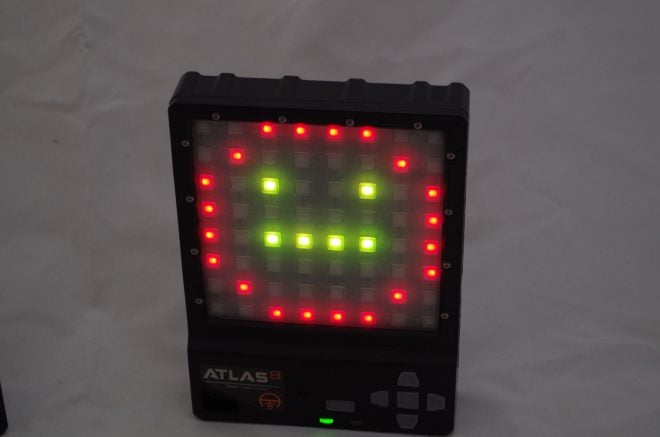In Part 1 of this article I discussed the premise and plan for seeing just how effective dry fire training would be using a number of products to augment the training. In this second part I will give my observations and conclusions. I encourage you to read the first article before continuing.
Observations
Ultimately I will let my final target speak for itself. While I technically still failed the Dot Torture Drill (because I had rounds outside of the circles), I had a marked increase in accuracy. Of course, you could argue that a blind quadriplegic could have shot better than my first run. Regardless of how bad I shot on my baseline (which I think was an exceptionally bad session), I definitely improved.
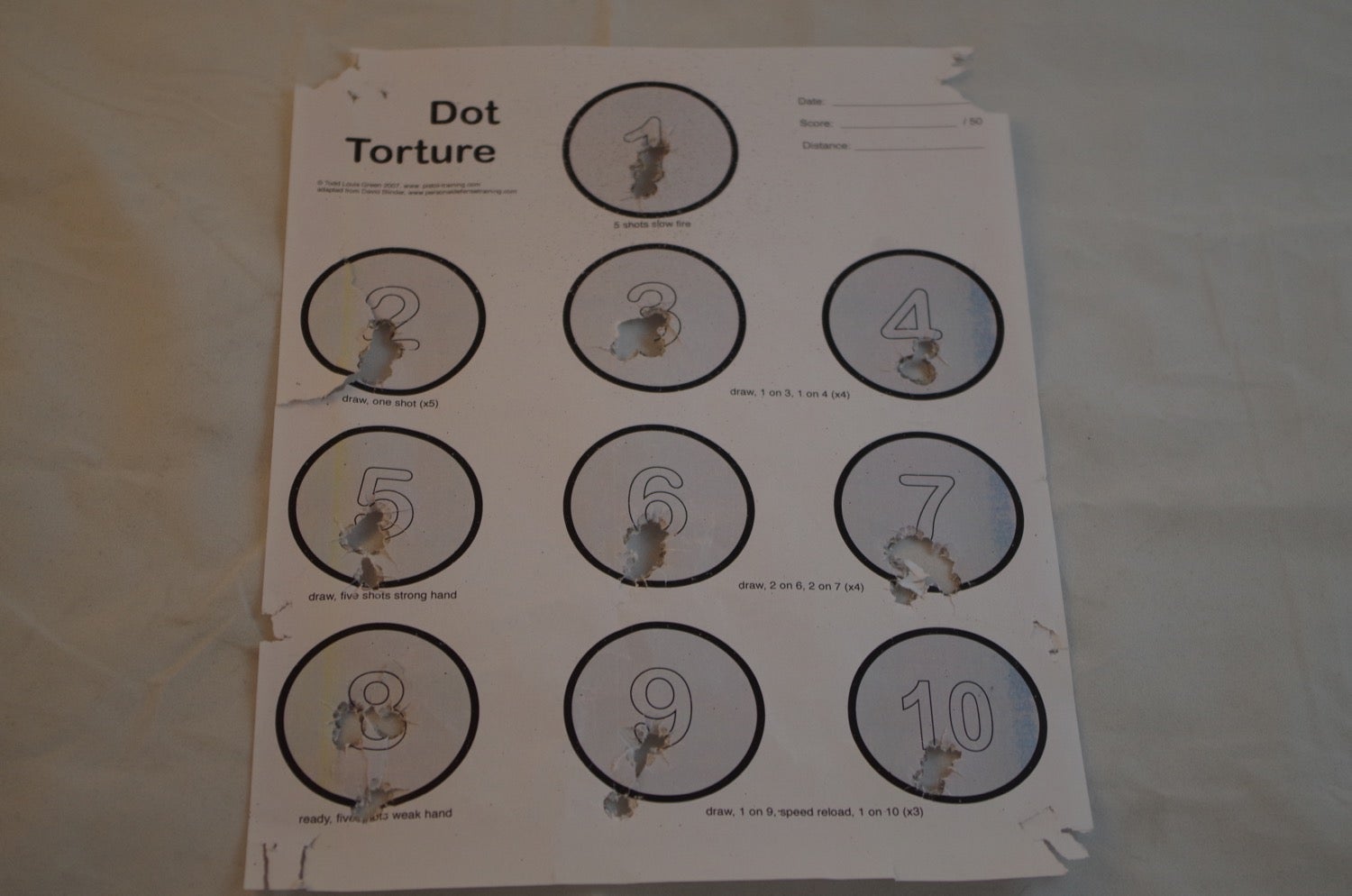
Significant Increase in accuracy and precision. the tl;dr is that dry fire DOES work. Compare it to my baseline…
Below I will discuss some of my observations regarding the various tools I used during the training.
Atlas 8
The Atlas, from Salted Earth, was probably the most fun out of all of the tools I used. It was certainly not the most realistic (it doesn’t resemble any real world targets), but it was the fastest to get up and running, and certainly the most compact.
Also, unlike the other systems, the Atlas can be used outdoors. The units will register a laser hit from a SIRT so long as the sun is not directly glaring on the unit.
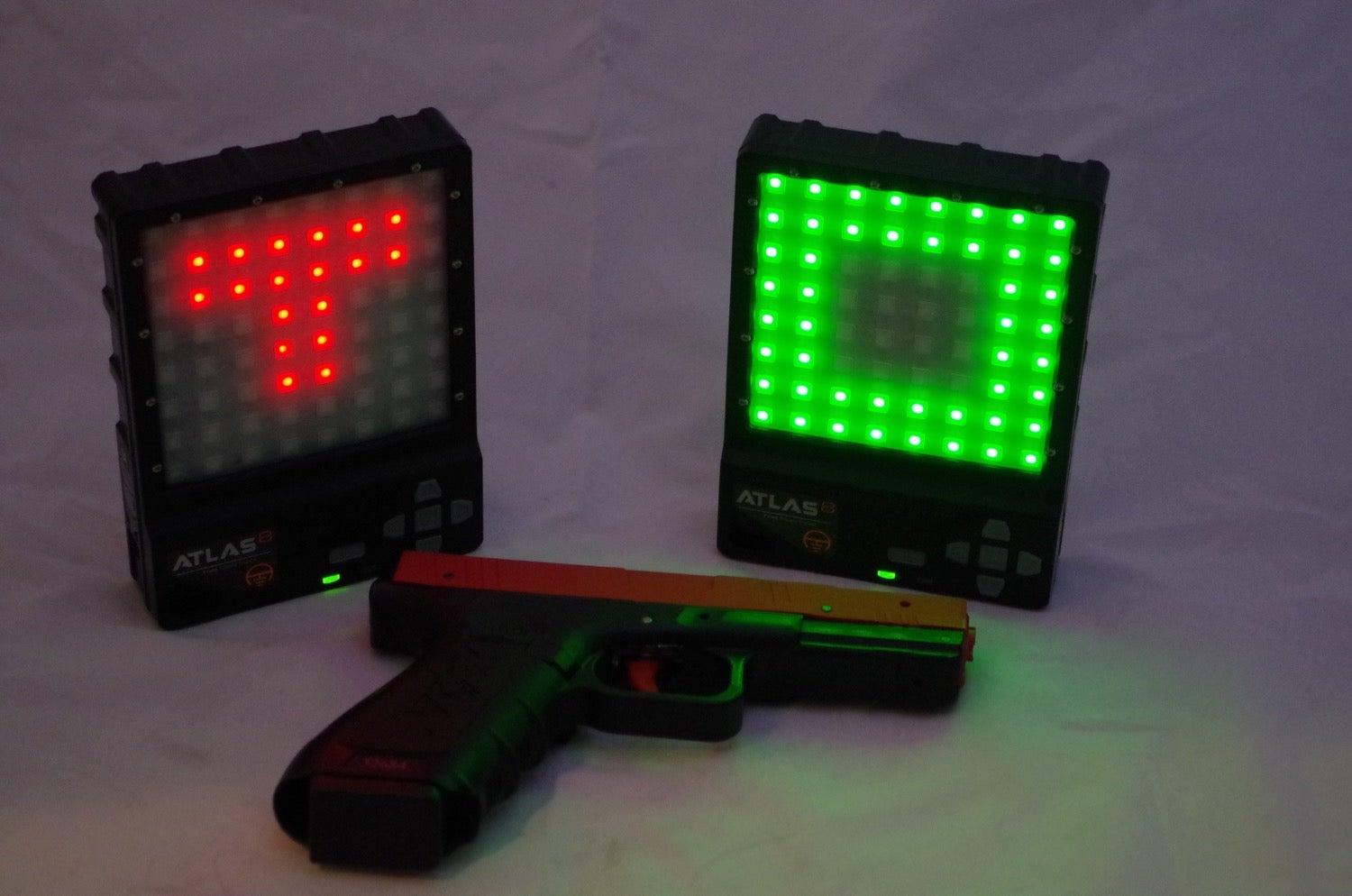
There are a ton of drills you can do with the Atlas8. It really keeps the training fun, and i”m sure there is training effect from using it.
Unfortunately I did not get to run these as long as I would have liked. During the middle of my “month” of dry fire, life got in the way, and so I really only shot on the Atlas about seven sessions before I had to send them back… 🙁
I did notice that occasionally it would not register hits, but I think that was specifically due to hitting one of the LEDs rather than a sensor.
The other downside is the price. The current units are all in the $600 range.
CoolFire
As the cornerstone of my setup this was the most important component. Overall the CoolFire system works very well, and the reciprocating action is exactly what I was looking for.
I do have a couple of problems with it, however. The first, and probably the biggest, problem is the laser itself. I found the laser to pulse too quickly and to not be bright enough. You can see an example of the difference between the CoolFire laser and a SIRT in the below video.
The CoolFire laser works great against the reflective targets that the system comes with but I didn’t find the laser to be sufficient to work with any of the other systems I tried. It did not work consistently with the ShootOff App and it did not work with the Salted Earth Atlas 8. When I was at SHOT (2016), it worked with the LaserAmmo reactive targets (and that was actually the reason I pleaded with my editor to get a CoolFire for testing and evaluation). CoolFire does manufacture the laser unit in house.
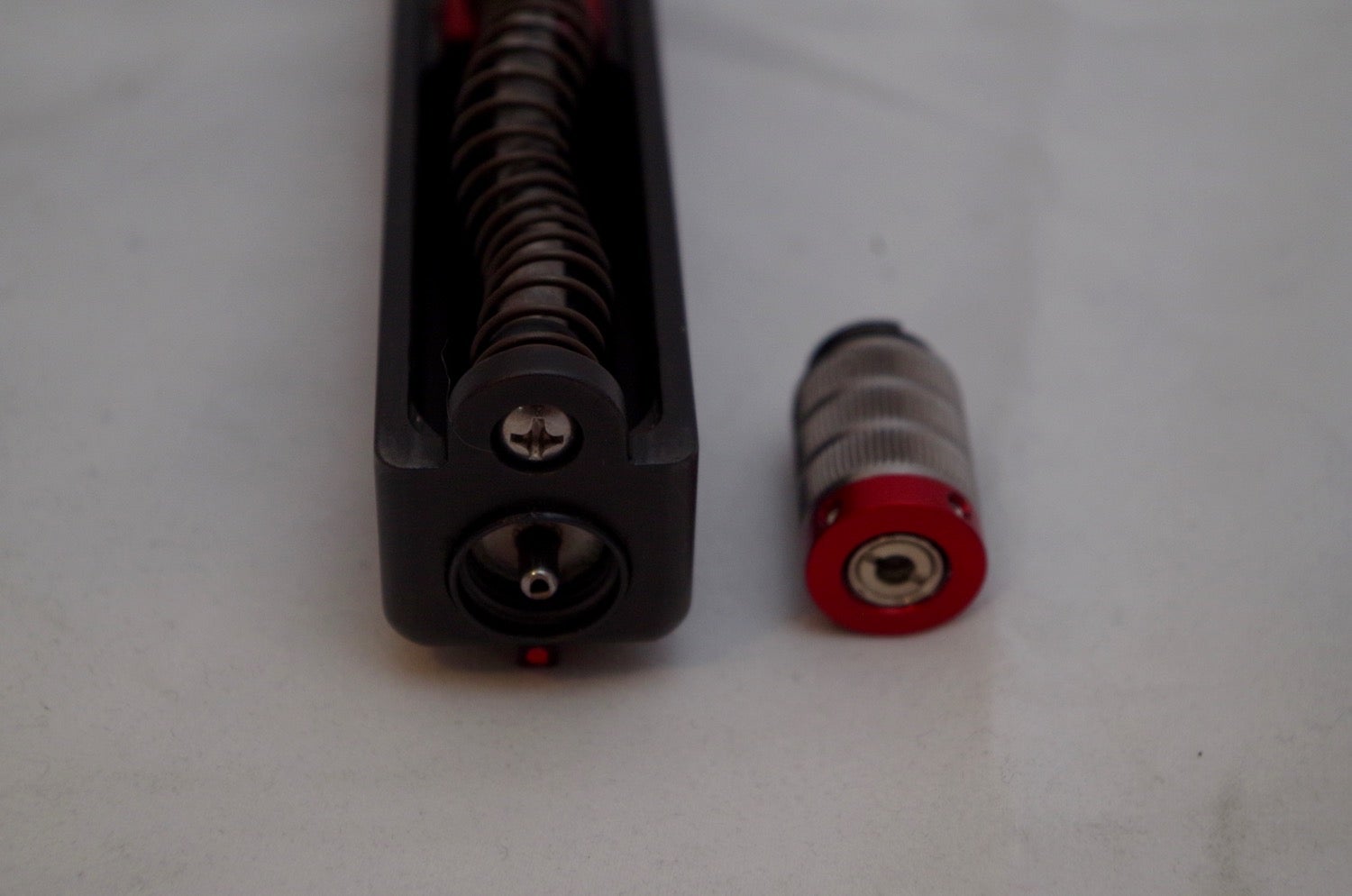
The CO2 filling nipple on the end of the barrel and the screw in laser unit.
Another thing that I found when running the CoolFire is that my pistol got cold. Like uncomfortably cold. Which makes sense as it is venting carbon dioxide with every shot. The related problem is that the CoolFire started misbehaving once the barrel and slide got cold enough. It would stop reciprocating the slide. I would have to stop training for about thirty minutes or so to let it warm back up enough. This would happen after about eight to ten fills (translating to eight to ten magazines; somewhere in the neighborhood of 150-180 shots), which inconveniently (or maybe conveniently) put it toward the end of my training session.
MantisX
MantisX was really my personal coach in all of this. But it seemed to be a personal coach that rarely gave me positive encouragement (I jest). I don’t think my manipulations are as bad as the Mantis app suggested–I found it really challenging to get it to register a clean hit with no problems during my training with the CoolFire. Of course I have always had a historic problem of “pushing” and the MantisX definitely picked up on that.
I initially had the MantisX forward mounted on the rail of my Glock, but that was challenging to use with my holster (until I upgraded to a competition speed holster; which I had planned on anyway). Austin (at MantisX) actually sent me a mount to replace the base plate of one of my magazines allowing me to mount the MantisX on the bottom of the gun. The change in location did not appear to have any affect on how it recorded the motions.
That said, the MantisX did actually work better with live ammo (which I tried after ending my experiment). I shot it from bench rest and it did start picking up clean hits, so I must just introduce some small error while actually shooting.
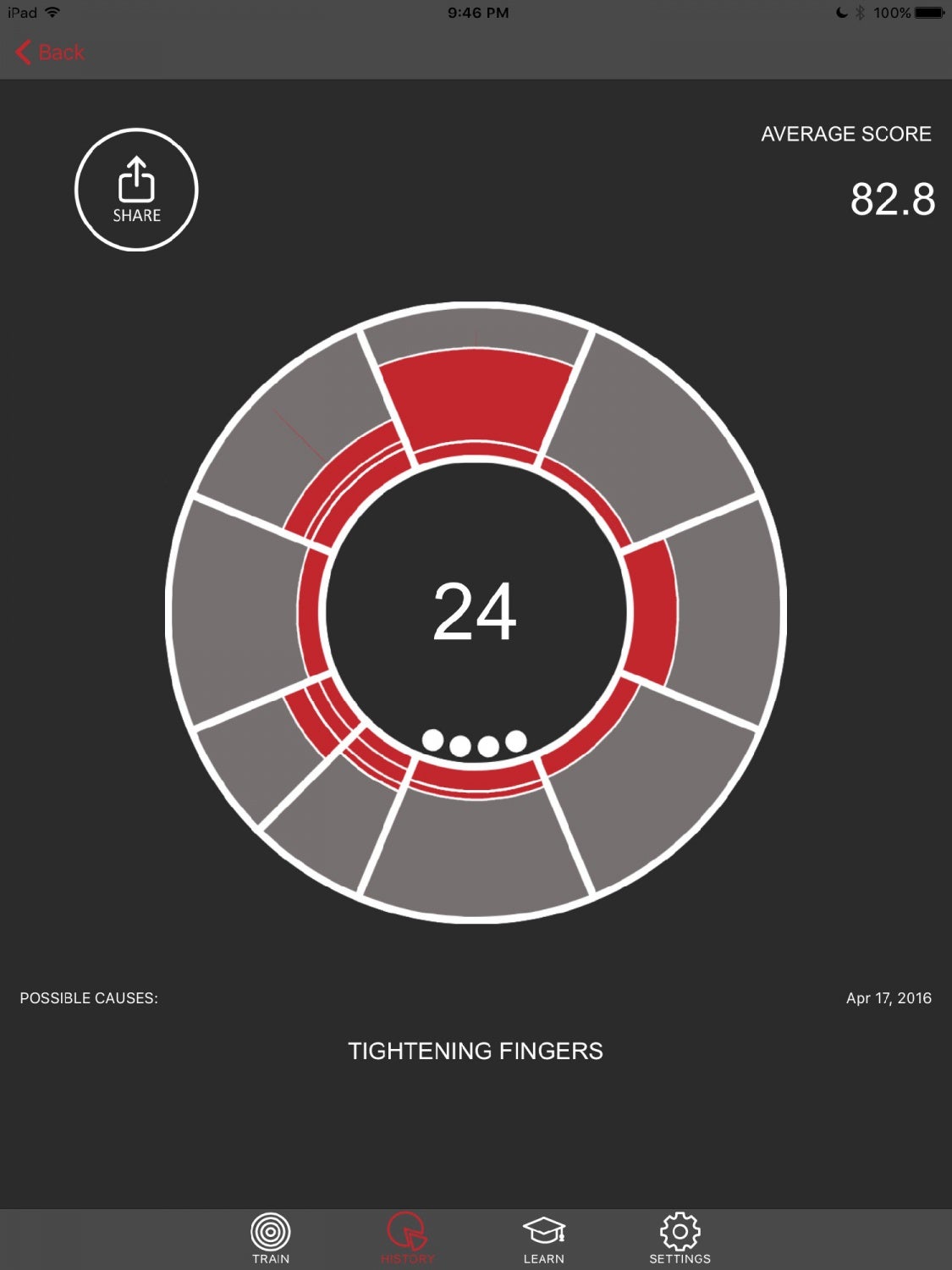
The MantisX gave the most useful feedback data of any of the systems I played with. (The Atlas8 tracks a bunch of stats, but they are not currently user accessible)
The MantisX team is also on top of updating their app, and adding new features, which made the system even better during my training.
ShootOffApp
I was highly disappointed with this app. It really showed a lot of promise and the idea that it is free and open source was appealing. Unfortunately that is also the problem. Many open source projects solve a problem at a basic level but never make it to the state of being polished enough for a wide distribution. Money is a great motivator to complete things, and unless enough people get behind a project and fund it (or contribute time) some projects will never realize their potential.
In all fairness I only ran this on a Mac Book Pro.
I found the app to be exceptionally slow and it used an extreme amount of resources, keeping my processor pegged. I attribute this to the language the app is written in–Java. The language allows it to run anywhere, though not in a terribly efficient manner (in my long experience with programming). Pretty much any Java app I run sucks resources…
One of the recommended cameras (Logitech c270) was completely insufficient and did not have a high enough frame rate to be able to consistently recognize the laser strikes, specifically from the CoolFire. It did work *okay* with a SIRT pistol. I bought another camera to try and see if that made a difference (this one a high frame rate; which was surprisingly difficult to find). It seemed a little better. I also tried in a number of lighting scenarios to see if that made a difference–not really any difference.
The interface was a bit rough and confusing. The easiest method for use is “standalone”. Basically you can print out a target and put it on the wall. You point the camera at it and then select one of the preset targets in the app. You generally need to resize the digital version (so that it overlays the camera image) as this is what defines the hit areas. One annoyance is that you can only resize from the top/bottom or left/right sides, and not the diagonals–basically you cannot maintain aspect ratio. Another problem was a specific target with five rounds. I printed it out, put it on the wall, and the corresponding digital version had a slightly different layout–there was no way to line it up (meaning that strikes on the paper did not correspond to registered strikes in the app).
[UPDATE (07-JUN-2016): I spoke with one of the developers and will be doing a dedicated review of ShootOFF as soon as they release the 4.0 version. They said that the issues I raised were known in the release I had, and have been addressed. So be on the lookout for a review–I’m hoping it will be the glue to tie the other training components together!]
Conclusions
Despite a number of challenges with the training plan and implementation, I did, in fact improve quite significantly. Dry fire does work–at least it did in my case. I think I would have had an even more dramatic change if I could have trained the way I had intended and if all of the components had worked together as I had envisioned.
I am generally not a fan of regulations, but I am a firm believer in common standards. I think one of the biggest things that companies involved in the business of creating “dry fire” training tools (specifically laser based tools) need to do is sit down in a room together and come up with some common criteria they can all agree on with regards to the laser emitter and the laser receiver. There should be a minimum pulse length and power for lasers. And receivers should have to register hits within that range. All of the companies should be striving to work with one another’s equipment to give the broadest range of equipment.
The reality of the situation is that it is currently not feasible to meet all of the criteria I set forth for a training system that would translate to a true measurable improvement on the range. Despite having pretty advanced technology available to us (like that amazing pocket computer that can also make phone calls), there is currently not enough collusion (nor, I would imagine, incentive) among the players in this space to make fully interoperable products.
Until that time comes, I think a dry fire training system that can fully replace range time is still going to remain a pipe dream. You can get some benefit from any of the products that I was fortunate enough to evaluate, but none of them complete enough of the puzzle (independently or together; nor at a reasonable enough price point) to solve the problem–being able to effectively train without having to go to the range.
I would like to give a huge thanks to CoolFire, MantisX, and Salted Earth for sending me units to run this experiment with. Despite not being able to realize my pipe dream, each of these tools are great in their own right, and I think anyone would gain an advantage by utilizing them. I’m still holding out for a full integration, though… 🙂
 Your Privacy Choices
Your Privacy Choices
